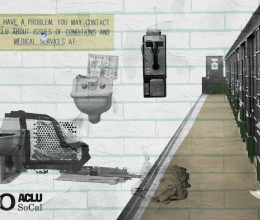
March 12, 2020
Sheriff-Coroner Donald Barnes
Undersheriff Robert Peterson
Assistant Sheriff David Sawyer, Custody Operations Command
Commander Joseph Balicki, Custody Operations Services
Director Richard Sanchez
Deputy Director Erin Winger, Correctional Health Services
RE: COVID-19 Policy in Orange County Jails
Dear Sheriff-Coroner Barnes, Undersheriff Peterson, Assistant Sheriff Sawyer, Commander Balicki, Director Sanchez and Deputy Director Winger:
We would like to meet with you within the next two weeks to discuss your plans for the prevention and management of COVID-19 in Orange County jails. People in jails are highly vulnerable to outbreaks of contagious illnesses. They are housed in close quarters and are often in poor health. Accordingly, it is very important that you take appropriate steps to protect the health of the people in your custody, the people who work in the jails, and the broader public.
We were glad to see in the March 6 monthly briefing that the Orange County Sheriff’s Department (OCSD) and Orange County Health Care Agency (OCHCA) are working together to develop a policy to address COVID-19. However, there are several concerns and recommendations that were not addressed in the briefing and that we wish to discuss with you:
- Early release: We encourage you to assess sentenced individuals who are particularly vulnerable to COVID-19 for immediate release, unless there is clear evidence that release would present an unreasonable risk to the physical safety of the community. The Centers for Disease Control and Prevention (CDC) has classified as vulnerable those who are elderly and those with asthma, cancer, heart disease, lung disease, and diabetes.
Because jails are congregate settings, where staff and people who are incarcerated will necessarily be in contact with one another and the outside community, they do not have the infrastructure to contain a virus. Restrictive responses, such as lock-downs, would worsen the conditions for those inside, putting their health and safety at risk. The only meaningful way to keep people inside and outside of the jails safe from COVID-19 is to decrease the total number of people who are incarcerated. To further reduce the population beyond those who are most vulnerable, therefore, we urge you to immediately accelerate the release of all individuals who have 30 days or fewer of their sentence remaining pursuant to Penal Code Section 4024.1. We would like to discuss further mechanisms for early release, including work release. - Release protocol: Individuals in custody may not be held after their scheduled release date. How will the release protocol for those potentially housed in quarantined areas ensure that individuals are not held after they are scheduled to be released?
- Cite and release: OCSD should cite and release all those who are eligible pursuant to Penal Code Section 853.6, rather than booking them and potentially introducing COVID- 19 into the jail system.
- Provision of hygiene supplies: The most basic aspect of infection control is hygiene. There must be ready access to warm water and adequate hygiene supplies, such as soap, both for handwashing and for cleaning. Individuals in the jail must also be informed about the virus and the measures they can take to minimize their risk of contracting or spreading the virus. What is OCSD’s plan for insuring that people who are incarcerated have hygiene supplies, and that they are provided at no cost?
- Treatment: Courses of treatment must be evidence-based, available immediately, and in compliance with scientifically-based public health protocols. What is the plan for treatment beyond quarantine and housing in the medical ward?
- Staffing plans: Regardless of how many staff stay home because they are sick, the jails will have to continue functioning. There must be a plan for how necessary functions and services will continue if large numbers of staff are out with the virus. OCSD and OCHCA staff must also be screened to ensure that they are not bringing COVID-19 into the jails.
- Vulnerable populations: The plan must provide for additional precautions for those who are at high risk of serious illness if they are infected, such as pregnant women and people with chronic illnesses, compromised immune systems, or disabilities. People whose housing placements restrict their access to medical care and limit the staff’s ability to observe them are also vulnerable and must be addressed in the plan.
- Data collection: The collection of data regarding COVID-19 should be part of the public health response. As with any contagious disease, data collection and sharing is critical to understanding and fighting the virus. The jail system must be part of this process. The same information that is tracked in the community must be tracked in the jails and shared with the public at large.
Please let us know when you will be available to discuss your plans with us.
Sincerely,
Jacob Reisberg
Jails Conditions Advocate
Daisy Ramirez
Jails Policy & Conditions Coordinator
